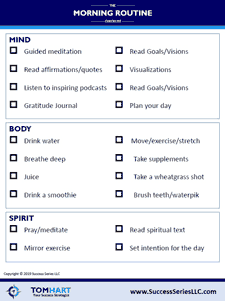“How do I form habits that stick and how long does it take?”
“How do I form habits that stick and how long does it take?” I often get that question from clients and audiences. How long it takes is the easier question to answer because the answer is always “It depends on the person and the desired habit”. There are various schools of thought as to how long it takes to form a habit. It’s usually somewhere between 21 days and 90 days. I believe the length of time it takes varies depending on the person and the habit. Some new habits might be very easy to create, while others may take more time and effort for that very same individual.
While the time may vary, I don’t think the process varies much from habit to habit or from one individual to another. Here then is my take on how to form habits that stick.
How To Form Habits That Stick
To form habits that stick, first make the decision to act or do something in a specific way.
With your personal resolve you will be able to overcome any challenges that come up, any obstacles to forming new habits or breaking old habits, and be able to persist. So one must always make a decision at the onset and clearly see the benefits of the decision.
The second step to take to form habits is to take immediate action in the direction of the habit.
Once you decide, you must immediately take action. This will solidify it in your body and psyche. For example, if you decide to rise early and exercise each morning, tonight set your clock for a specific time, and when the alarm goes off tomorrow morning, immediately get up, put on your exercise clothes and begin your exercise session.
Now, going forward, don’t take exceptions to the action.
For instance, if you resolve to get up at 6:00 am and take a run, don’t hit the snooze alarm once or twice and finally roll out of bed at 6:20. Exceptions are the root of all new habit demise. It’s easy to rationalize exceptions when they seem isolated. Important interruptions come in many forms such as unexpected visitors, technical malfunctions or simply a late night out. If you let one exception creep into your plan, it becomes easy to let another slip by, and soon your whole goal is derailed. Commit to the goal without exception.
Fourth, tell others of your habit (or desire to stop).
It is amazing how much more disciplined and determined you will become when you know that others are watching you to see if you have the willpower to follow through on your resolution. It’s easier to allow exceptions or deviations from your goal when you are the only that knows.
Now, visualize yourself performing the new habit and the benefits it brings.
The more often you visualize and imagine yourself acting as if you already had the new habit, the more rapidly this new behavior will be accepted by your subconscious mind and become automatic. The same muscles are activated whether you are physically or mentally imagining a task: this means you actually derive the benefits of practice in both situations. This even applies to physical behaviors like golf or dance. You can bridle your fears in your visualizations before you venture out into the real world. By visualizing, you also allow yourself to problem solve for expected obstacles and be ready for them when they happen in reality.
Next, create an affirmation or a mental mantra that you can repeat over and over.
Combining affirmations with visualizations is a powerful tool. The repetition of a affirmation, or other mental mantra, dramatically increases the speed at which you develop the new habit. For example, you can say something like; “I get up and get going immediately at 6:00 each morning!” Repeat these words the last thing before you fall asleep. In most cases, you will automatically wake up minutes before the alarm clock goes off, and soon you will need no alarm clock at all. It’s true that what you focus on grows. Simply filling your mind with more of what you want to achieve is an undeniable strategy for changing your mindset. Directly and intentionally, change your thought patterns.
Now, be sure to persist in the habit until it becomes automatic.
Better yet, do it until it becomes awkward when you don’t! This is a true test of transformation. While personality is arguably inherent, anything is learnable and you can change any behavior if you are committed. Some habits take hours to change while others take years. Only you will know when you have fully embodied the change and have reached your goal. And only when you stay strong and committed to your goal will you no longer gravitate towards old, automatic behaviors, and finally reap the benefits of the new, desirable behavior.
The last, and most important step to form habits, is to celebrate!
People often overlook this step because they soon start to take their new habit for granted and act as if it were always that way. But you really do need to take the time to celebrate, to create the demarcation between the old and the new, from what was and what is now. Acknowledge the improvement. Reinforce the effort made and know that your subconscious is now driving the bus in a good way.
If this topic is of particular interest to you, visit my friend Brian Tracy, whom I attribute much of what you just read, to learn more about forming habits. And, please let me know of your interest in this topic by commenting below and I will expand on this topic in future posts; your feedback is greatly appreciated. Let me know whether you like, or dislike, the topic and of other topics you would like addressed in future posts.
If you, or a friend, want to join the Tom Hart Success Series Community, visit my website to receive email notifications of these blog posts, learn of upcoming events, and of other news by clicking on the offer to receive the first two chapters of my book Getting From Here To There for FREE!!



